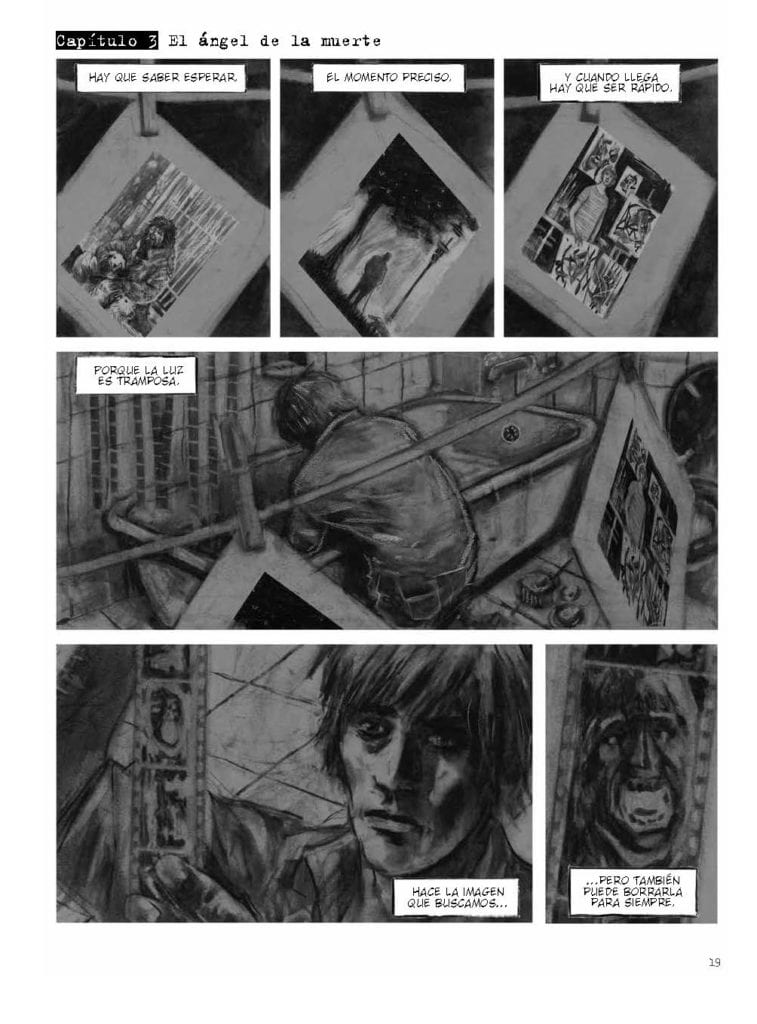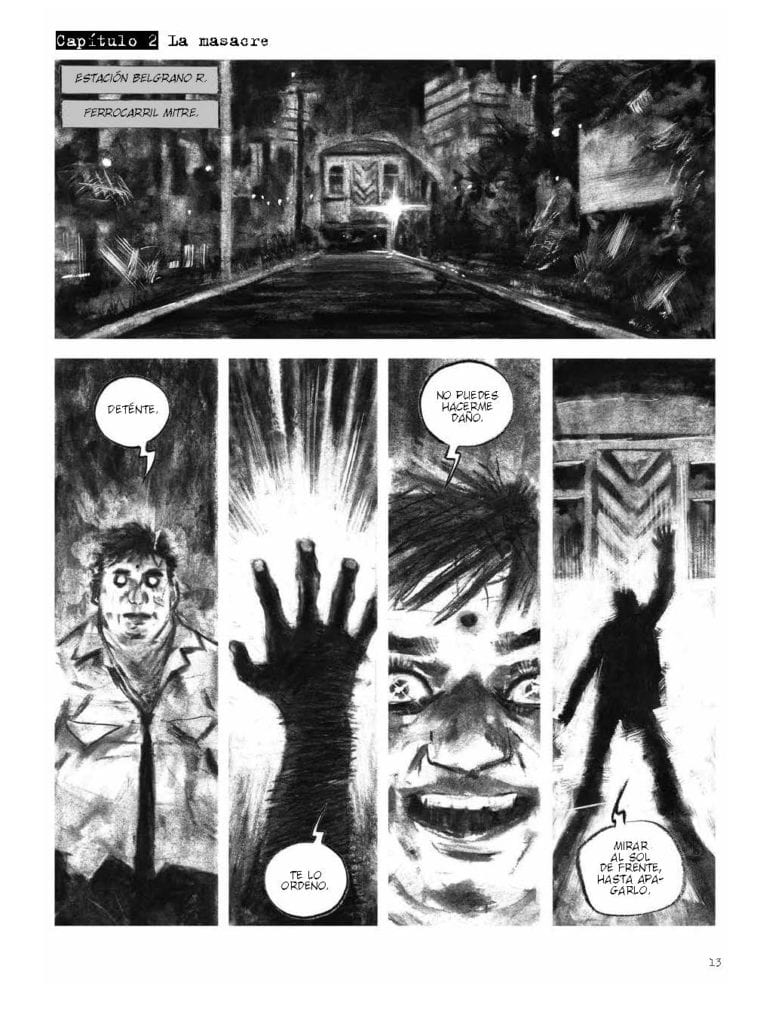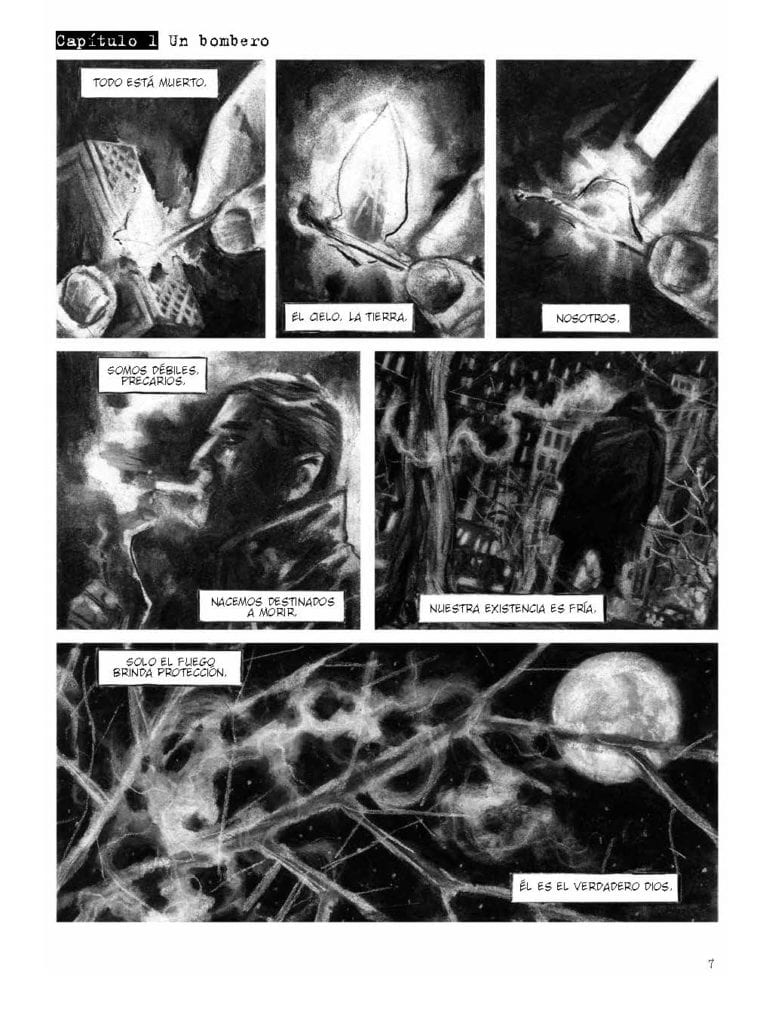The creation of art and poetry is a chemical reaction of things that aren’t quantifiable. It can’t be observed in any sort of logical sense. It is a spark that comes alive in cafes and bars, and in cramped bedrooms or in front of the family piano. Writer Diego Arandojo and artist Facundo Percio do their best to describe a storm of nocturnal creativity in Beatnik Buenos Aires, a fictionalized account of the artistic thunderstorm that was this South American city during the 1960’s. Written in a combination of poetic verses and sparse dialogue, and visualized in smoky charcoal drawings, this graphic novel from Fantagraphics is an evocative love letter to the creation of art and the mad geniuses who live for its birth.
“When night falls in Buenos Aires, the city comes alive. Artists flock to cafes and dives to exchange ideas, listen to music, watch outré performance art, pen poetry, fall in love. In these raucous, smoke-filled rooms, the bohemian heart and soul of this vibrant city, a conflagration of creative energy burns. With the improvisational pacing of a jazz performance, Beatnik Buenos Aires follows the lives of writers, painters, musicians, sculptors, and performers as they wend their way through these hubs of creative life, seeking out inspiration and grappling with their craft. Set in 1963, this graphic novel celebrates a time in Argentine history when its art scene blossomed.”
Writing & Plot
In Beatnik Buenos Aires, Diego Arandojo sets out to portray the experience of living in the 1960 Buenos Aires nightlife art scene though a combination of believable reality and the very poeticism this movement created. He accomplishes this not via a standard A-to-B plot, but rather a staccato of short chapters from the perspective of different artists, writers, and musicians. This sort of bouncing around from person to person is held together by the setting of Buenos Aires and its signature bars, cafes, and coffee shops (the birthplaces and natural environments for creative types. There’s an improvisational feel to the book as a whole that is completely unique and addicting, though admittedly its lack of cohesion may alienate some readers looking for a more traditional story. While there is certainly a lot of love for this era displayed within the main pages of the book, there are also notes at the end which provide context for each chapter, including background information as to each character and who they represent – or directly are meant to be – in real life. Arandojo notes that there is some fictionalized embellishment in these stories for the sake of entertainment, but the heart of the stories are still largely true. It’s easy to feel the care that Diego puts into each use of words and poems, instilling a grander (if sometimes inexplicable) meaning to this work. This graphic novel not only set me down in the room with these men and women, but made me nostalgic for my own experiences among creative peers. As an English major who made a lot of friends with writers and poets, the barroom and coffee shop scenes of artistic discussion reminded me of similar moments in my own life. The moments in the book are way cooler and more intriguing, obviously.
MFR ON YOUTUBE (latest video)
Help us reach 5K Subs!
Art Direction
While it’s Arandojo’s love for this microcosm of creativity that ultimately conceived this book, the art of Facundo Percio is what brings Beatnik Buenos Aires to life. Percio’s charcoal black-and-white visuals instill a sense of historic gravity and unmistakable character to the entire book. You would think that rendering an entire graphic novel in this style, especially with a huge cast of characters, would make the stor(ies) seem monotonous. However, Facundo manages to bring the liveliness and expressiveness of these people and their city into the story through this style in a manner completely unique to this book. The smoky charcoal grays and blacks work almost symbolically, living in tandem with the cigarette smoke, black coffee, and ink-written words found in every tale. Every character very much has their own look and sense of expression also, which is doubly amazing due to Percio’s technique. The panels flow from situation to situation and time to time with ease, like the passages and poems they are meant to dissect. The visuals here are so singularly significant that it’s actually a bit difficult to offer a critical view; the gray and black renderings of 1960’s Buenos Aires and the Avant Garde artists who gathered in its PM hours are burned into my brain and it makes me want to write. The highest compliment I can give.
When a comic really gets me (or a story of any medium really, just most often it comics), really reached into my mind and hits my taste in just the right spot, it for some reason makes me desperately need a cup of coffee and a cigarette (and I don’t even smoke). This book incited this reaction, but also explained that this was perfectly normal behavior according to South American artists in the 60’s. Beatnik Buenos Aires is a love letter to a time that was a hurricane of artistic creation. It is a tale of two cities, one of the vanilla 9-5 side of Buenos Aires, and more importantly the nocturnal side when all the artists come out to drink coffee, trade ideas over cigarettes and alcohol, and seek to experience all the uniqueness and originality that can be had in other artists. Diego Arandojo pays tribute to real artists and poets through a series of unique short stories that roll out like an improvised jam session. The smoky charcoal grays and blacks of Facundo Percio craft the perfect tone and aesthetic for this graphic novel with images and scenery that will from now on be seared into my brain. While this is surely not a book for everyone, if this does sound up your alley, be sure to grab a copy when it hits shelves on 4-27.

